Grapes have been extremely important in China for more than 2000 years (Shaohua Li 2001; Kong 2004). In fact, grapes are one of the country’s most important fruit products along with apples, citrus fruits, pears and bananas. Grapes can be divided into two basic groups: table grapes and wine grapes (some table grapes can be also used to make wine, but in general, the members of each group are best used for what they are known to do best). Just like Italy, France and other grape-growing countries of the world, China grows both table and wine grapes: at last count, China reportedly grows more than 1500 grape cultivars with practically all of its provinces boasting at least a few varieties they can call their own.
A country with as long a history as China’s cannot but help to have plenty to say in the field of agriculture. And given the important association of wine with human-related activities throughout millennia of human existence, it cannot surprise that the country has plenty to say in relation to viticulture too. The first plants of Vitis vinifera grapes, the vine species used to make fine wine all over the world (for example, Pinot Noir, Nebbiolo and Riesling are all vinifera grapevines) were likely first grown in the imperial city of Xian from seed brought to China in 128 bce (or before common era, which is a secular reference term similar to BC, or Before Christ) by General Zhang Qian who was returning from Tashkent. The General is still honored as the father of the Chinese wine industry by many Chinese wine professionals (there’s a statue of him standing at the Dynasty Winery in Tianjin). Because of the importance of trade with the West and the many foreigners who travelled to China over the centuries, vinifera grape varieties from Europe and elsewhere had a way of finding their way into the country: according to Nunez and Walker (1989), many new grape varieties arrived into China through the Silk Road. Therefore, viticulture was well-established in the country already by the second century ce (common era or Anno Domini, AD). To a smaller extent than in Europe, Catholic missionaries also played a role in spreading viticulture to pockets of China, as has been well-documented in the province of Yunnan, for example. In the thirteenth century, Marco Polo, a keen observer, outstanding writer and a fellow who knew a little something about travelling, described the florid vineyards and wines of the Xinjiang.
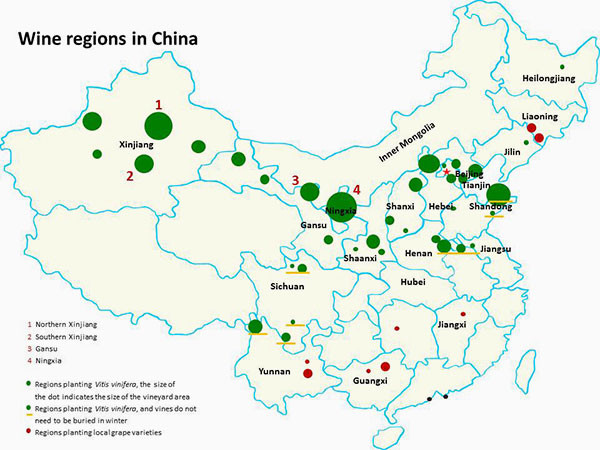
Over the centuries, the result of introducing foreign grapevines into different Chinese habitats was two-pronged. First, the original names the foreign grapevines were known by at the time of their arrival onto Chinese soils were slowly modified, if not downright lost, over time (and some are still unknown today). Second, through the combination of both long-term cultivation (meaning the application of human para-domestication efforts and selection pressures aimed at propagating what were perceived to be more desirable ampelographic and viticultural traits of the native and imported grapevines being grown) and the adaptation of these imported grapevines to the climatic and geological realities of their new homes (by way of random and non-random mutations induced into the grapevine DNAs) many “new” cultivars were born, rightly becoming viewed as being local Chinese cultivars. It follows that, rather logically, local farmers proceeded to attribute new names to the new/ “new” grapevine varieties they were growing. (This is something we have also seen happen, time and again, throughout the centuries in Old World wine-producing countries such as Italy, France and Spain, among others.) When the modifications induced in the new grapevines are relatively small and the new grapevine still closely resembles the original mother plant (in terms of vine morphology and behaviour as well as in its wine’s characteristics) we speak of biotypes; by contrast, when the differences present between the original (progenitor) grapevines and the new grapevines formed over time are marked, then we speak of new, distinct varieties altogether. The difference between biotype and distinct variety depends on the extent of the “degree of change” in the grapevine morphology/behaviour and the wines made; when those differences become noteworthy, a new monicker is applied to what is a de facto new grapevine. For example, China’s Cabernet Gernsicht may well be “only” a Chinese biotype of Carmenère or of Cabernet Franc (which one of those two it is depends on who you read and believe, but I suggest you base your conclusions on data published in peer-reviewed academic journals, which is the only acceptable and credible scientific data); but given how different Gernischt looks and how different its wines are from those made with Carmenère and of Cabernet Franc, a reasonable case can be made it is, and should be, viewed as a distinct variety altogether. Recent Chinese estimates are that many local grape cultivars exist in China, and currently over 1500 grape accessions (individual different grapevine plants) of both native and foreign grapevines have been collected from different Chinese vineyards and propagated to experimental vineyards for study and research purposes.
Besides the many international (foreign) vinifera grape varieties that everyone knows about such as Aglianico, Cabernet Sauvignon, Chardonnay, Malbec, Petit Manseng, Riesling, Sangiovese, Sauvignon Blanc, Syrah, Tempranillo and many more that have been planted in China, the country also boasts its own share of native grape varieties and species. For example, much like North America has its highly-typical Vitis berlandieri and Vitis riparia, Asia, and China in particular, have many grapevine species that are their own. In other words, grape varieties that are native to individual Asian countries. And while North American vines have not had much success as sources of fine wine mostly because of the foxy characteristics of the wines made with them, and are therefore mostly used nowadays for rootstock production or the creation of new hybrid grape varieties (think of Vidal Blanc, for example), the study of the exact winemaking potential of many Chinese wild grapevine species has been an only recent event. The learning curve has been a fast one, as we shall see; but there is still much to learn on this interesting and potentially very useful subject.
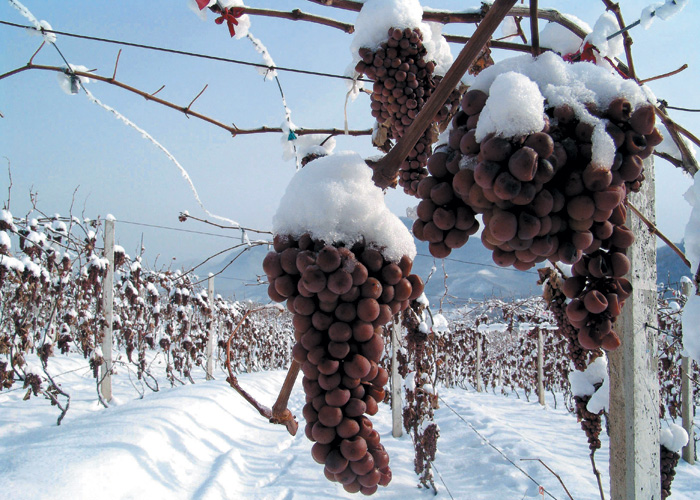
It cannot surprise that with grape production for both table and wine grapes becoming increasingly important in China throughout the twentieth century, simply importing grapes was no longer a feasible approach. Therefore, long-term planning for grape production was necessary, and this led to research with different objectives, such as the identification of new varieties; locating growing regions suited for new vineyards aimed at quality wine production; and developing strategies for increasing production. Clearly, the weather and landscape extremes that characterize China, the world’s third largest country, offer a mind-boggling array of often very different and even extreme habitats for plant and animal life. Animals and plants cannot live and grow just anywhere: after all, you would neither expect to find snow leopards living somewhere that is hot and dry, nor cacti growing where its freezing cold, correct? The same is true of grapes. When it comes to quality winemaking, the extreme, long, dry, cold, and snow-filled and even snowless winters that are typical of parts of China (mostly in the north) or the rain-plagued southern reaches of the country call for the planting of very specific grape varieties in each specific habitat. And the factors to consider are truly numerous. Relatively short growing seasons often marred by late-season frost episodes or the very humid harvest conditions in coastal areas such as those of the Shandong Province also call for specifically adapted grape varieties that perform better than perhaps more famous grape varieties but that are at a clear disadvantage in such specific habitats. For example, in the wet Shandong province, Cabernet Franc usually does much better than Cabernet Sauvignon, which is too prone to rot-problems in many parts (but not all) of that province. By contrast, in provinces where winters are ultra-cold and vinifera vines need to be buried in order to survive winters, the planting of hybrids or natural vines that have good winter hardiness helps to create a sustainable wine industry there where international vinifera grapes may not survive at all. Clearly, the need to identify the right Chinese habitats for each international grape variety was an absolute necessity; but at the same time, so was the need to identify new grape varieties that might be better suited to the realities of climate, topography and geology that distinguish China from other grape-growing and wine-producing countries. The latter option can be tackled by creating, studying and assessing laboratory grape crossings and hybrids that might prove well-suited to the country’s more extreme growing environments.
Another reason to perform studies and research on local and the adaptation of imported grape varieties to Chinese viticultural habitats was simply the desire to produce better wines from what grapevines had been planted: in other words, with the growth of the Chinese wine industry and better/increasing wine sales, more attention begun to be paid to grape and wine quality rather than productivity, which further spurred the study and the creation of different, new, grape varieties. Yet another reason to begin grape research programs in earnest was to better monitor the health status of grapevine material. With unchecked importation of plant material, the risk of also importing many viral and non-viral diseases into China was all too real (consider that in 1998, there were 4.5 million cuttings imported into China from France alone, but clearly cuttings were imported from other countries as well, making for a very large amount of imported vegetal material). Health-related issues (not just in viticulture and wine production), are always an undesirable consequence of unchecked movement from one part of the world to another (this is something that should be by now tragically apparent to all my readers: just think of Covid and the necessary, life-saving, travel restrictions imposed on all of us during the height of the pandemic). Clearly, with the rapid growth of China’s surface under vine, there was a need for government-control of health status monitoring of grapevine material being imported and planted in China. All of which explains and helps to understand the flurry of Chinese grape research activity that has taken place over the last seventy years or so.
Grape variety research and breeding in China
Grape variety research and breeding started in earnest in China by the early 1950s, and has progressed rapidly: according to Shaohua Li, over the past sixty years, more than two hundred grape cultivars were approved and/or developed by more than forty institutions or growers in China. At first, two national grape germplasm repositories were developed: the Zhengzhou Fruit Research Institute of the China Academy of Agricultural Sciences (located at Zhengzhou in the Henan province) and the Institute of Fruit Research (Pomology) of the Shanxi Academy of Agricultural Sciences (located at Taigu, in the Shanxi province). Between 1,400 and 1,500 varieties were collected in the grape germplasm collections of these two institutions. The study of these grapevines included the creation of new Chinese varieties of grapes, by mating different vinifera species together (the resulting new grapevine is a grape crossing) and by joining vinifera with non-vinifera species (and in this case we speak of a grape hybrid). And besides creating new varieties, the parentage and genetics of grape varieties have been studied, as well as cold resistance, flower types, phenological phases and economic return of different grapevines (native, international, crossings and hybrids). Clearly, it is the information gleaned from such studies that led to specific academic and nursery cross-breeding and parental selection processes. So far, this laboratory and field activity has led to the creation of mostly table grapes, but new wine grapes, some quite successful, have been developed as well (see my upcoming report here in the TerroirSense Wine Review on Puchang Vineyard’s very successful wines made with the Beichun grape). Besides those already mentioned, other Chinese institutions involved in grape breeding include the Shandong Agricultural University, the Jilin Institute of Special Local Products, the Inner Mongolian Institute of Horticulture, Hebei’s Changli Institute of Pomology, and Xinjiang’s Institute of Horticulture of the Xinjiang Academy of Agricultural Sciences as well as the Shanshan Research Center of Grape, Melon and Fruits Exploitation, plus the Institute of Horticulture, Shanghai Academy of Agricultural Sciences and more.
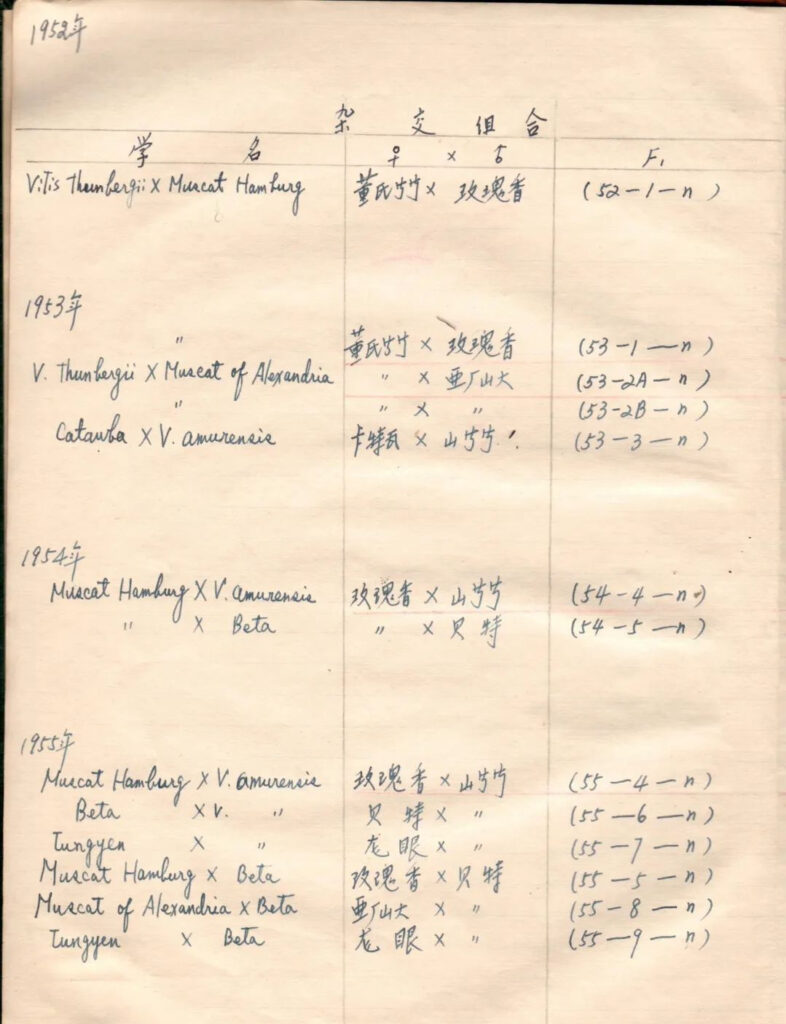
Chinese wild grapes and winemaking potential
According to Zhang Fengqin, Luo Angmei and Gu Dabin, nearly half of the roughly eighty Vitis species in the world are native to China (with more new local species currently being studied). Recent data from Beibei Li, Xiucai Fan, Ying Zhang and Chonghuai Liu (2021) have shown through the study of genetic diversity and population structure analysis using Simple Sequence Repeats (SSR) identification that the Chinese wild grapes are more genetically close to European grapevines than to North American species. Of the many Chinese local Vitis species, by far the most famous (and at least based on the wines I have tried over the years, the most interesting from a winemaking perspective, I may add) is Vitis Amurensis. Other local Chinese wild species that have both table grape and fine winemaking potential are: Vitis Flexuosa and its variant Vitis Flexuosa var. parvifolia, Vitis Davidii, Vitis Piasezkii, Vitis Bryonifolia, Vitis Pentagona, Vitis Adsricta, but there are others. And even if the research being conducted on these grapevines should show that all are not suitable to the making of fine wine, such plants are often found to have many other useful traits and roles, such as providing a new source of rootstocks, hybrids, seed oils, pharmacological / medical products and ornamental / gardening / landscaping entities.
Chinese Vitis species appear to be most numerous in the middle and lower reaches of the Yangtze River and the region of the Nanling range; by contrast, China’s North-West and North-East appear to hold smaller numbers of wild grapevine species (that much admitted, beware that the most important Chinese wild grapevine of them all, Vitis Anmurensis, is actually native to the country’s extremely cold North-East). The previously mentioned 2021 study by Beibei Li and associates shows that the clustering patterns of most accessions correlated with the geographic distribution. An analysis of molecular variance (AMOVA) revealed that 3.28%, 3.27%, and 93.46% of the variance occurred between populations, between individuals within populations, and between individuals within the entire population, respectively. To put that in simpler terms, what this means is that Chinese native wild grapevines can be classified in specific groups based on where they grow most commonly. Therefore, according to their geographical distributions, there are four main groups of grapevines: G r o u p A is made up of twenty different species that live in Jiangxi, Guangdong, Hubei, Hunan, Henan, Zhejiang, Shaanxi, Fujian, Sichuan, Jiangsu, Anhui, Guangxi, and Yunnan, with each region growing anywhere from twelve to twenty species. There are possibly ten wild grapevine species included in G r o u p B and these grow in Guizhou, Gansu, Hebei, Shanxi, Shandong, and Taiwan, with each viticultural area growing anywhere from six to ten species. G r o u p C consists of three species (in Hainan, Tibet and Inner Mongolia), with each area growing ether two or three species. There is only one species in G r o u p D (in Heilongjiang, Jilin and Liaoning) and that is Vitis Amurensis. This study has provided us with more information on the state of Chinese wild grapevines, as previous to this research, an interesting 2015 study published in the Journal of Horticultural Science by Liao, Zhu and He, suggested that Chinese wild grapevines belonged to three groups only: the original group (which includes Vitis Adstricta, Amurensis, and Yenshanensis); the intermediate or moderately evolved group (which includes Vitis Pseudoreticulata, Quinquangularis, and Romanetii); and the evolved group (in which Vitis Bryonifolia, Piasezkii, and Davidii are found). A brief description of the main Chinese wild grapevines follows here; clearly, I focus on those with fine winemaking or wine-related potential.
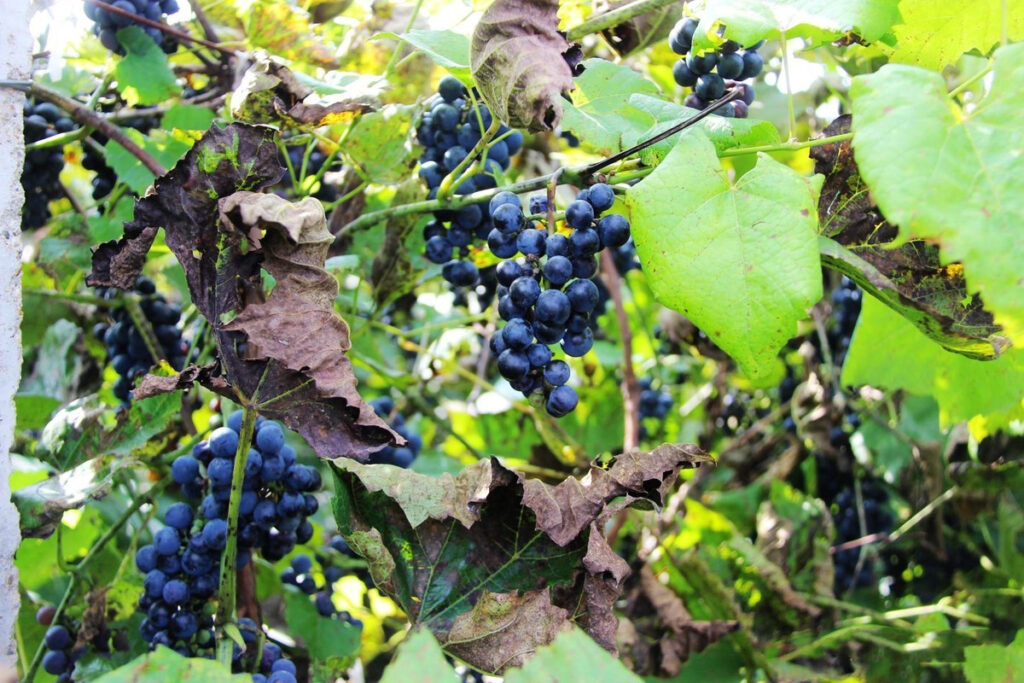
- Vitis Amurensis
Known as the Amur River or Amur grape in English, and as 山葡萄 or shan pu tao in Chinese, this mostly dioecious (unisexual individuals that have separate male and female reproductive organs: by contrast, most grape cultivars are hermaphrodites, in other words possess both male and female reproductive organs in the same plant) grapevine is the hardiest of all Chinese wild grapes. Its geographical distribution will tell you that immediately, given that Vitis Amurensis is able to live in different parts of the country, but dos so especially in the coldest, northernmost part of China (it lives in forests, shrublands, hillsides, and valleys from 100 to 2100 meters above sea level in Anhui, Hebei, Heilongjiang, Jilin, Liaoning, Shandong, Shanxi, and Zhejiang). As crazy as it may seem, it can tolerate and survive temperatures of -40 to 52 degree Celsius: for comparison’s sake, and to help you put those numbers in perspective, consider that most vinifera grapevines start dropping like flies at -25 degrees Celsius. Vitis Amurensis is resistant to most common vineyard diseases such as powdery mildew and white rot, but not so much to downy mildew. Its leaf has three to five lobes (though more rarely they can be orbicular/circular in shape too), with shallow indentations. It turns bright-purplish red come autumn (in fact, the young leaf is yellowish-green but with a light purplish red tone). The leaf’s lower page (surface) is downy, covered with extremely thick, light-yellow hairs (tomentum). The grape bunch is conical or cylindric, quite loose, and with small, round grapes that have thick, dark purple skins, with on average four seeds in each berry. It is a vigorous vine, but one that does not build up huge amounts of sugar. It tends to bud earlier in the year than the common vinifera species, blooms around mid-May, and colour-change of the berries is in mid-August. When pressed, the juice is bright red-purple in colour, making this a teinturier variety. It is a grape that is used mostly for local red wine production, but also as a food-colouring agent (much like the Ancellotta variety is in Italy and Brazil). Clearly, its disease-resistance and hardiness makes it an ideal component of breeding programs (inheritance of the variety’s characteristic traits is strong). Interestingly, when Vitis Amurensis was crossed with early- or late-ripening varieties, the progeny tended to be mid-late or late maturing (in other words, the progeny in these cases is neither early- nor extremely late- ripening). Especially in the coldest parts of China, Vitis Amurensis is used as rootstock to increase cold resistance (disease resistance too) in grapevines that would otherwise need to be buried to pull through the winter, thereby providing a huge cost-cutting and time-saving advantage.
- Vitis Ficifolia
Vitis Ficifolia is a native wild vine of China that also grows in Japan and the Koreas in the temperate climate zone. It is another high-yielding, hardy variety that tolerates below zero temperature (down to -20 degrees Celsius) and does not need to be buried come winter time. It is also disease-resistant to both powdery mildew and downy mildew. The young leaf is yellowish-green with a dark red tone, and here too the lower page has a thick, hairy tomentum. The leaves have three shallow to five deep lobes that don’t really turn red but rather yellowish-brown in the autumn. The bunch is small and loose, with small and round grapes that have thick skins and not much pulp (but only one to two seeds). Its growing season is pushed late in all its viticultural phases (bud-break, bloom, and colour-change of the grapes all occur later than they do in common vinifera grapes and as much as one month later than in Vitis Amurensis). When pressed, the grapes yield a dark red juice. The small grapes mean it is not suitable for table grape production while the thick silvery tomentum makes it ideal for use in the ornamental, gardening and landscaping purposes. But it has been used for breeding purposes too, crossed for example with Muscat Hamburg and the Muscat of Alexandria (Zibibbo) leading to the creation of the new varieties Beifeng and Beizi, respectively. These are two potentially very interesting wine grapes.
- Vitis Davidii
Vitis Davidii, also known as the Chinese bramble grape, is a native wild grapevine of China first discovered by Père David in Shensi in 1872 and introduced by him to the garden of the Paris Museum that same year. It is a very disease- and weather-resistant, long-lived wild grapevine. Differently from all the other major Chinese wild native grapevine species, its shoots are covered with spines, many of them hooked towards the top end. It has large, indented leaves, that unlike some other native Chinese wild grapevines are not especially downy (the lower page of the Vitis Davidii leaf is essentially hairless). A sub-variety of the species, Vitis Davidii var. cyanocarpa (originally known as Vitis armata Veitchii) is more scrawny-looking, with sparser spines and smaller leaves than the classic Vitis Davidii. The grapes of the classic Vitis Davidii are also large, round, thick-skinned and contain good volumes of juice (there’s one to two seeds per grape), and that differently from the juice of the Amurensis and Ficifolia varieties is quite sweet. The grapevine tolerates very humid and hot, dry climates; at the same time, it fares well in conditions of low sunlight hour totals too. Given its disease- and weather-resistance, it is ideal for breeding new cultivars ideally suited for wet and hot climates (such as the coastal ones of southern China). Interestingly, though it is dioecious variety, in recent years hermaphrodite individuals have also been found, a clear-cut example of how grape varieties morph over time leading to the creation of new biotypes and varieties.
- Vitis Piasezkii
A native of Western and Central China, it was at originally known as Vitis Sinensis in the West, receiving an Award of Merit in the United Kingdom when exhibited under the latter name by Veitch in 1903. Of all the Chinese native wild native grapevines species, it is the one with the most variable leaves, that range from essentially lobeless to having five lobes, with hardly any separation between the lobes to deep indentations. The leaf margins are sharply-toothed and the lower page covered by a brown felty tomentum. The shoot and leaf stalks are also covered with brownish hairs. The grape bunch is cylindrical, and the dark purple-coloured grapes are covered in thick bloom. Best of all, they are very sweet to eat and yields are normally copious. Very resistant especially to fungal diseases, it makes both an excellent table and wine grape, and is also valuable for breeding. The subspecies known as Vitis Piasezkii var. pagnuccii has nearly glabrous (hairless) shoots and leaves, and even the lower surface of the leaves have little hair.
- Vitis Romanetii
Originally referred to as Vitis Romanet du Caillaud and first documented by Caillaud in the Western scientific press in 1883, the variety is known as 秋葡萄 or qiu pu tao in China. The species is hermaphrodite (in other words, it has both male and female organs) and grows well in light (sandy), medium (loamy) and heavy (clay) soils, but prefers them to be well-drained and with a high calcareous content. Closely related to Vitis Davidii, it does not have that variety’s cold-resistance. Vitis Romanetii lives in forests, shrublands, hillsides between 100 to1500 meters above sea level but cannot grow in the shade. In China, it is found in Anhui, Gansu, Henan, Hubei, Hunan, Jiangsu, Shaanxi, and Sichuan; outside of China, it grows in northern Laos. Locals use the leaves to cook with, wrapping other ingredients within them and then baking, with the leaves releasing a gentle, inviting flavour to the foodstuffs inserted within. The grapes are good to eat and used to make wine. A subspecies called Vitis Romanetii var. Tomentosa was described by Cao and He in 1994.
- Vitis Flexuosa
This wild grapevine lives in China, Japan and Korea (and was originally sourced in Hubei, China). Its leaf is small (amongst the smallest of all the Chinese native wild vines), round or triangular but truncated at the top, narrow, and has uneven teeth; the leaf stalk is downy. The grapes are dark purple in colour, round, quite small (pea-sized) and with one to two seeds; the grapes are quite acid in taste. A very adaptable grapevine, it tolerates humid and hot climate and lives long, though it is slightly less resistant to some pests than are Vitis Davidii and Vitis Adstricta. Vitis Flexuosa var. parvifolia has been reported to be a specific subspecies commonly grown from the Himalayas to central mainland China Taiwan, but my understanding is that many luminaries consider it to be a distinct grapevine species altogether. It is more abundant in European ornamental gardens than Vitis Flexuosa. To the best of my knowledge, I am not aware of anyone having made wine with it or even bred it to create new wine grape varieties, but I may well be wrong.
- Vitis Quinquangularis
This vigorous, hardy variety is a native of Central and Western China; it it is also known as Vitis Pentagona. Like Vitis Flexuosa to which it resembles especially in the appearance of its leaves (narrow, almost oval, round or pear-shaped, with at most three barely distinguishable lobes), it is an ornamental grapevine rather than one used to make wine. The shoots and leaves of Vitis Quinquangularis are downy; no member of the Vitis group of grapevines has a downier inferior page than Quinquangularis. The grapes are blue-purple in colour and round, with two to three seeds per single grape. Fairly disease-resistant, it is used in laboratory settings mostly because of that quality. A subspecies, Vitis Pentagona var. honanensis has leaves with marked indentations and very narrow sinuses. It is mostly distributed along the Qinling range in China’s Shaanxi Province. Another subspecies, Vitis Quinquangularis var. bellula, differs from the others because of its much smaller leaves.
- Vitis Adstricta
Also known in China as 浙江蘡薁 or zhe jiang ying yu, this variety has been very well described by P. L. Chiu in a 1990 paper published in the Bulletin of Botanical Research. Vitis Adstricta’s small, trilobate leaves have both surfaces covered with sparse, very short fine hairs as do the shoots (reportedly covered with brownish hair in South China and pale ones in North China). They tend to turn red in autumn. The grapes are round and dark purple in colour. It features good adverse climate- and disease-resistance, and therefore is used as a potential parent for breeding new cultivars which show good productivity and resistance to humid and hot climates as well as to diseases. The Vitis Adstricta var. ternata subspecies is specifically native to, and lives only in, China’s Zhejiang Province where it can be found along small streambanks at about 600-700 meters above sea level. Locally it is known as san chu ying yu, meaning three-foliolate or three-leaflet ying yu (this term means “hard jade”). Though not all researchers appear to be in agreement, the grapevine known as Vitis Bryonifolia is also known as Vitis Adstricta Hauge, or蘡薁(原变种) ying yu (yuan bian zhong) or hua bei pu tao in Chinese (in English: the North China grape) and it is apparently not the same variety as classic Vitis Adstricta. Vitis Bryonifolia is also native to China where it grows in forests in valleys, shrublands, streamsides, and fields between 100 to 2500 meters above sea level in Anhui, Fujian, Guangdong, Guangxi, Hebei, Hubei, Hunan, Jiangsu, Jiangxi, Shaanxi, Shandong, Shanxi, Sichuan, and Yunnan.
- Vitis Pseudoreticulata
Vitis Pseudoreticulata, commonly known as the wild Chinese grape or eastern Chinese grape, is native to eastern China, specifically the Anhui, Fujian, Guangdong, Guangxi, Henan, Hubei, Hunan, Jiangsu, Jiangxi, and Zhejiang provinces. The plant grows at altitudes of 100 to 300 meters above sea level. It has a large leaf that is either pentagonal or kidney-shaped with fine indentations. The leaf’s lower surface of the leaf is lightly downy. The grapes very dark purplish in hue. A high-yielding variety, it is well-adapted to humid and hot climates and is most used today for the breeding of new cultivars adapted to the climatic conditions of southern China and has been studied in this regard in recent years by the Institute of Horticulture of Shanghai Academy of Agriculture Sciences. Furthermore, the naturally high resistance of Vitis Pseudoreticulata to powdery mildew, which is genetically determined in this variety with the production of the protective PR-4 (Pathogenesis-Resistant) protein in the variety’s leaves induced by the presence of powdery mildew (as published in 2016 by Lingmin Dai, Dan Wang, Xiaoqing Xie et al). The PR-4 gene expression is significantly higher in leaves of Vitis Pseudoreticulata following attack by powdery mildew than it is in normal conditions).
Clearly, apart the varieties I have given short descriptions of above, China boasts many other wild native grapevines species, including for example Vitis Wilsonae, Vitis Yenshanensis, and Vitis Rutilans.
Successful new grape crossings and hybrids
As mentioned previously, relative to grape breeding, techniques of interspecific hybridization and intervarietal crossing are carried out widely at different institutions and university research centers all over China. Li Demei has documented brilliantly the history of Chinese grapevinegrowing and winemaking in numerous works over the years, and other Chinese luminaries have done so as well. It all means that today we have plenty of information that helps us understand the rapid growth of Chinese wine, which is the result of many factors; for sure, research and development have contributed importantly to China’s rapid rise in the production of quality wine. In 1951, the Jilin Institute of Pomology produced Gongniang No.1 ( a Muscat Hamburg x Vitis Amurensis hybrid) and Gongniang No.2 (Vitis Amurensis x Muscat Hamburg). Gongniang No. 1 proved interesting because of its extreme cold resistance, such that it does not need to be buried to avoid winter kill (this even in places where temperatures reach as low as -22 degrees Celsius). Even better, it is a disease-resistant variety providing good crop loads and good grape and wine quality (wines made with this variety, such as those of the Tonghua Winery of the Jilin Province, have been awarded medals at wine competitions). Gongniang No.1 is grown in Jilin, Heilongjiang, Liaoning, Gansu Provinces and the Inner Mongolia Autonomous Region. Heishan is a new grape variety that was obtained at Xingcheng Institute of Pomology, Chinese Academy of Agricultural Sciences, by hybridizing Black Hamburg and Vitis Amurensis: another variety, Shanmeigui, was born by hybridizing Muscat Hamburg and Vitis Amurensis in 1952.
Shortly thereafter, China hit the proverbial jackpot with the creation of its Bei series of grapes. These are very successful Muscat Hamburg and Vitis Amurensis hybrids obtained at the Beijing Botanical Garden of Institute of Botany of the Chinese Academy of Sciences in 1954. Without doubt, Beichun, Beihong, and Beimei (all of which can survive the coldest winters) have proven to be stellar table and wine grapes. Beichun in particular has proven ideally suited to making fine wines (read my upcoming, first of its kind, Beichun vertical in the TerroirSense Wine Review at the end of the month). Beichun is a disease- and cold-resistant variety that not only does not need to be buried in the winter, but guarantees high yields and high sugar concentration in its grapes. Today it is grown to alrger or smaller degrees everywhere in China and has proven particularly successful in the humid environments of southern reaches of the country where most wine grape varieties have trouble growing.
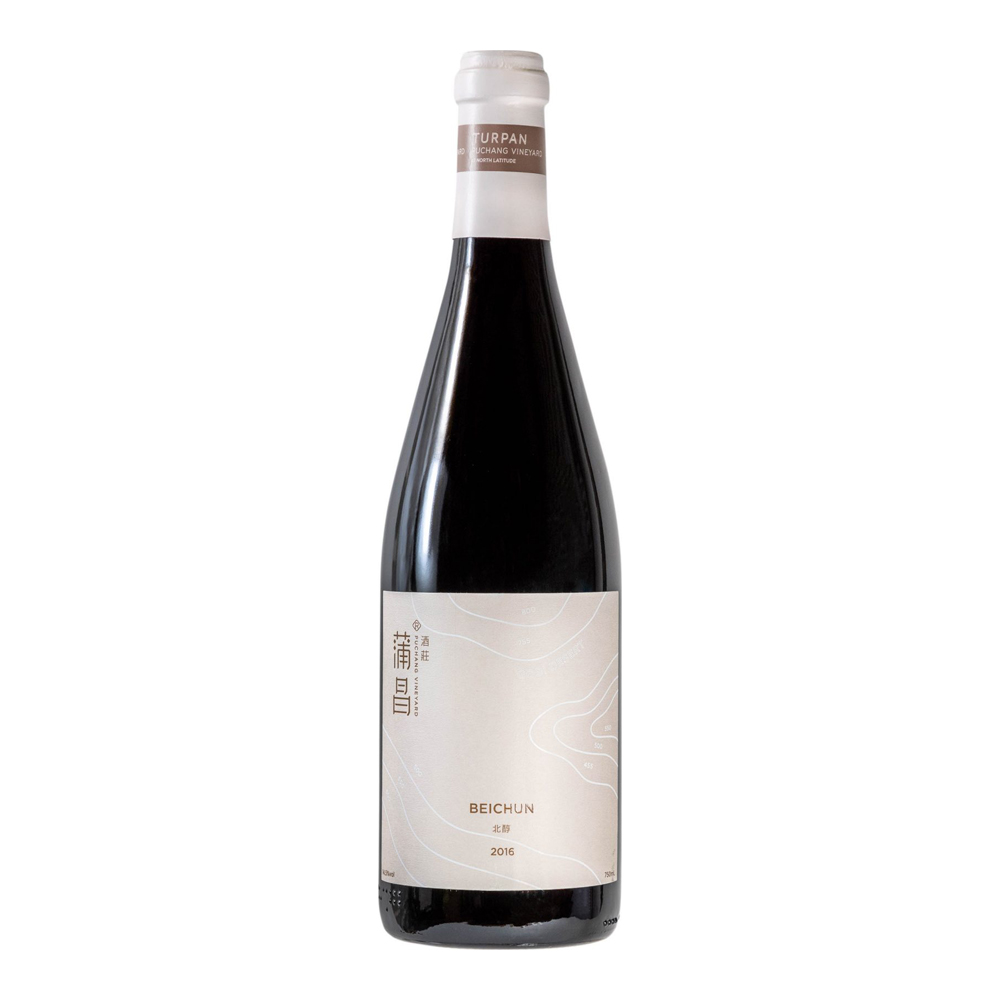
In 1957, it was the turn of the Shandong Institute of Wine Grape to have success in grape breeding. The goal was two-fold. First, to breed varieties that could be used to make high-quality red or white wine and that could be grown in the areas of middle and lower reaches of the Yellow River. Second, to obtain table grape varieties ideally suited to being packaged in tin cans and for juice production. Merlot x Petit Verdot crossings saw the light of day, as well as others, including Quanbai (a Riesling x Verdot crossing) and Quanyu (a Riesling x Muscat Hamburg crossing) for white wine production; and Meiyu, Meinong, and Meichun for red wine production. Another grape, Hongzhilu, was developed that proved good both for red wine production as well as a source of pigment. Baotuhong, the product of Sweet Water and Vitis Amurensis was born in 1964; it is a cold- and disease- resistant variety ideally suited to making red wines. All are reportedly widely planted today in the country. Over the years, many other grape varieties have been created at different Chinese research institutes all over the country. For example, in 1962 the Zhengzhou Institute of Pomology of the Chinese Academy of Agricultural Sciences developed Zhengzhou Zaohong (an offspring of Muscat Hamburg x Pearl of Csaba), and Heijianiang (a Seibel No. 2 x Carignan product). Both these varieties are reportedly popular in the area of the former course of the Yellow River, with Heijianinag especially showing strong disease resistance, good ripeness levels and ruby-coloured, high-quality wine. Xiongyuebai was bred in 1967, a cold-resistant grape that is the offspring of Longyan and a progeny of Muscat Hamburg x Vitis Amurensis ; it too is considered to give good quality white wines. Tenturier varieties have also been developed over the years: for example, Yan No. 73 and Yan No. 74 (two offsprings of Alicante Bouschet x Muscat Hamburg), launched by the Yamai Winemaking Company in 1966.
It should be apparent by now that over the last sixty years many new grape cultivars were bred with local cultivars in China (Chang and Liu, 1993; Liu et al., 2002; Guo et al., 2012). Grapevines are widely grown today in more than twenty provinces and municipalities in China: most vineyard land is in northern China, with Xingjiang, Shadong, Liaoning, and Hebei provinces and regions producing more than 40% of China’s grapes (Shaohua Li 2015). However, more work is needed to further characterize Chinese grape varieties by studying the genetic relationships among the local varieties and introduced/imported cultivars in China. At the same time, more research and trials need to be done in identifying the best possible regions in which to plant vinifera grapes and which go best where. Clearly, not all the newly created Chinese crossings and hybrids will one day become household names and their wines the darlings of the international wine-loving set. But others might, and likely will, because they offer the possibility of making good quality wines in areas where no wines could have been otherwise made before. Grapes that offer the world’s, not just China’s, many wine lovers entirely new wines boasting colours, aromas and flavours unlike those of other wines made elsewhere in the world. The legacy of Chinese native wild grapevines and laboratory crossings, as well as of their researchers, is an important one: for they have all not just helped create new wines, but perhaps even more importantly, helped everybody gain a better and deeper understanding of China’s many different terroirs and winemaking possibilities. To that, I, and all wine lovers, cannot helps but raise a glass and say an emphatic Bravo!

 English
English



